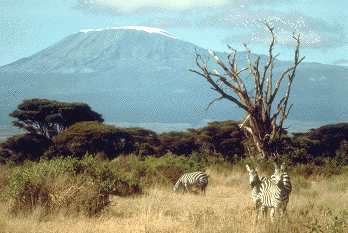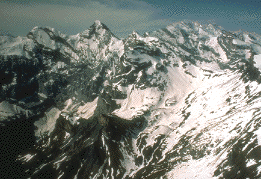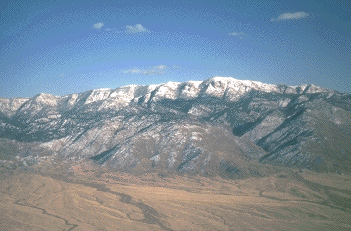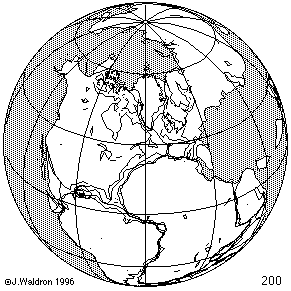


Other mountains are part of extensive mountain belts such as the Alps shown below.

Some owe their uplift to faulting:

whereas others have been uplifted as the terrain was folded.

Most geologists argree that the continents have gradually grown larger by the addition of linear mountainous terrains to their flanks.
Orogenesis is the name for the set of processes that collectively produce mountain belts. You should be able to locate the following mountain belts:
Although folding is often the most conspicuous sign of these forces, faulting, metamorphism and igneous activity are present in varying degrees.
The concept of a floating crust in gravitational balance is called isostacy. When a ship is loaded, the ship settles into the water. When the ship is unloaded, it "floats higher". During the Pleistocene glaciation a 3-kilometer sheet of ice covered the Hudson Bay region in Canada. The underlying crust was depressed. Removal of the ice has resulted in uplifting of some 300 meters in the last 10,000 years. Convection may also help keep crustal areas uplifted.
Mountain belts take a long interval of time from start to uplift. Many studies show that deformation began in the deep water, marine margin and proceeded toward the interior of the continent. Volcanism often accompanied the deformation of these deeper-water sequences.
The shallow, near shore deposits are often deformed by both folding and thrust faulting as deformation proceeds.
When two oceanic plates converge, one will be subducted beneath the other. Partial melting and the upward migration of the resulting andesitic magma produces Island Arcs that often develop mountainous terrains as they are eroded.
When an oceanic plate meets a continental plate, the oceanic plate (denser) is subducted beneath the continental plate.
Passive Margins are the first stage in the development of Andean-type mountains. During this stage a thick wedge of shallow-water sediments accumulate adjacent to a continental mass (such as off the east coast of North America at the present time. Turbidity currents may transport sediment out into deeper water.
Active Margins may eventually replace passive margins and the oceanic plate begins to be subducted beneath the continental plate. Sediment derived from the land and from the downgoing slab is plastered against the landward side of the trench to form an acretionary wedge. Partial melting and the production of andesitic magma results in active volcanos at the surface.
About 45 million years ago India collided with the Eurasian plate. Watch the following animation showing the break-up of Pangea. Note that about 200 million years ago there was a large "wedge-shapped" ocean - the Tethys - at the equator on the right hand side of the image. What happens to the Tethys? Follow the assembly of the southern margin of Europe and Asia.

Reload your page to start the animation
India continues to migrate north a few centimeters per year. Should a subduction zone develop south of India, the growth of the Himalayas would cease.
Plate tectonics provided an understanding as to how a mountain range could form within a continental interior. The Urals formed when proto Europe collided with proto Asia and the two were sutured or welded together.
Mountain ranges now in Greenland and Scandanavia formed at the same time as the Applachians. The orogeny lasted about 300 million years (the Paleozoic). The animation above begins with the breakup of a supercontinent. Welding of the supercontinent produced the Applachians and Caledonians.
These fragments may have been island arcs or microcontinents. When oceanic plates move they transport the microcontinents or island arcs. The upper portions of these thickened zones may be trhust from the descending plate as relatively thin sheets onto the adjacent continental block. This material increases the width of the continents. These accreted crustal blocks are called terrane.
| jbutler@uh.edu
|ClassListserv
|Textbook Home Page
|Glossary of Geologic Terms|
|Search These Pages|Other Courses|Resources|Grade Book|
Copyright by John C. Butler, July 29, 1995